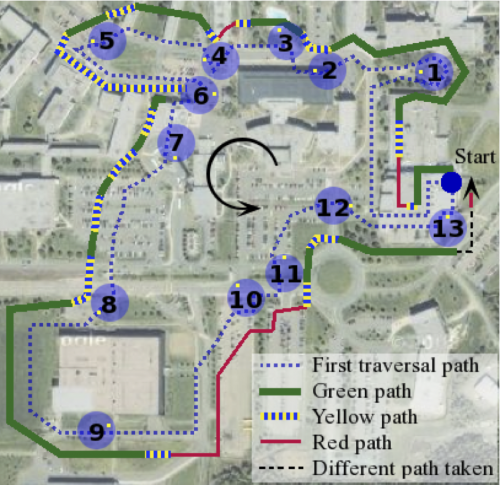Difference between revisions of "CTAB-Map"
(→Description) |
|||
| Line 45: | Line 45: | ||
<french> | <french> | ||
| − | ==Sommaire des détection de boucles sur l'ensemble de données UdeS1Hz== | + | ===Sommaire des détection de boucles sur l'ensemble de données UdeS1Hz=== |
* Vert : Fermetures de boucle acceptées | * Vert : Fermetures de boucle acceptées | ||
* Jaune : Fermetures de boucle rejetées | * Jaune : Fermetures de boucle rejetées | ||
| Line 53: | Line 53: | ||
</div> | </div> | ||
| − | ==Temps d'exécution pour chaque itération== | + | ===Temps d'exécution pour chaque itération=== |
<div style="text-align: center;"> | <div style="text-align: center;"> | ||
[[File:CTAB-Map_LoopClosureTimeResults.png|500px]] | [[File:CTAB-Map_LoopClosureTimeResults.png|500px]] | ||
Revision as of 18:48, 11 January 2011
CTAB-Map - Constant-Time Appearance-Based Mapping
Description
Loop closure detection is the process involved when trying to find a match between the current and a previously visited locations in SLAM (Simultaneous Localization And Mapping).
Over time, the amount of time required to process new observations increases with the size of the internal map, which may affect real-time processing.
CTAB-Map is a novel real-time loop closure detection approach for large-scale and long-term SLAM. Our approach is based on efficient memory management to keep computation time for each new observation under a fixed time limit, thus achieving <math>O(1)</math> complexity. Results demonstrate the approach's adaptability and scalability using one custom data set and four standard data sets.
Video[edit]
Results[edit]
Summary of the loop closures detected on UdeS1Hz data set[edit]
- Green : Loop closures detected
- Yellow : Loop closures rejected
- Red : Unable to detect a loop closure because old places could not be reactivated
Processing time for each image acquired[edit]
Publications
Labbé, M., Michaud, F. (2011), “Memory management approach for real-time appearance-based loop closure detection,” To appear in IEEE Transactions on Robotics.
Team[edit]
- Mathieu Labbé
- François Michaud


